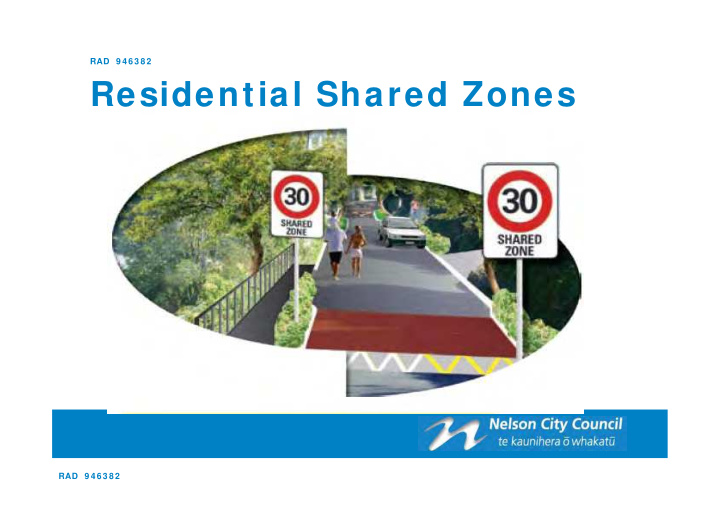



RAD 9 4 6 3 8 2 Residential Shared Zones RAD 9 4 6 3 8 2
W HAT ? • A Residential Shared Zone is a street where pedestrians and cyclists share the road with motor vehicles – with some added features that make it safer for everyone. RAD 9 4 6 3 8 2
FEATURES • 30 KPH speed limit • Specially-designed narrow entryways at each end of the street to slow drivers and make it obvious that they are entering a restricted speed zone • Tree plantings and other features, such as ‘speed tables’ to further encourage slower driving and improve the neighbourhood atmosphere • Improved street lighting where needed to avoid dark spots at night RAD 9 4 6 3 8 2
HOW do they w ork? • Slowing traffic makes it safer for pedestrians to share the road with vehicles– cars, motorbikes and bicycles. All traffic – on foot, bike or motor vehicle –shares the road, looking out for each other • Special signs, ‘speed tables’ (a slightly raised road surface about five metres long) • Planting at the entries to a Residential Shared Zone make it obvious to motorists that they need to drive more carefully and look out for pedestrians and cyclists. • The street can also be narrowed along the way with raised ‘berms’ to further encourage slow driving. RAD 9 4 6 3 8 2
They w ork best w hen…. People are considerate of each other: • All road users practice their ‘stop, look and smile’: friendly eye contact and every-day courtesy towards each other • Pedestrians have the right of way • Vehicles – including cyclists -- go slowly, give way to pedestrians and overtake only when it’s safe to do so • Pedestrians don’t block approaching vehicles unless they have to (for example, when walking past a parked car) RAD 9 4 6 3 8 2
W HY? • Some of Nelson’s residential streets are narrow, winding and without footpaths. • Philosophy consistent with direction of the RLTS, the draft Land Development Manual, the draft Resource Management Plan Change 14, and the NCC Urban Design Protocol Action Plan. RAD 9 4 6 3 8 2
W HO…. • New to Nelson and to New Zealand – few examples yet – note we are not talking about something like the UK Home Zones, with short wide flat paved street with kids playing soccer in the middle of them. • As this is a new concept to residents it will be important to educate and inform people about what a shared zone is and how it will work RAD 9 4 6 3 8 2
Advantages • Improve safety on Nelson streets that don’t have footpaths, where walkers and cyclists already share the road with motor vehicles • Minimum street widening and new tree plantings improve the neighbourhood’s character • Minimal or no retaining walls or other major works that reduce neighbourhood character, which are often needed if adding footpaths • Minimal reduction in on-street parking • Walking and cycling are great ways to get around, and Residential Shared Zones make this healthy choice even more safe and simple . RAD 9 4 6 3 8 2
Disadvantages • No footpath ( except on blind corners etc) – Pedestrian safety will be improved in comparison to the current road conditions, but a footpath w ould be safer still for pedestrians. – However a residential shared zone would be safer for cyclists than a standard road upgrade design (eg 50kph with footpath). • Slow er vehicle speeds – but unlikely to be a problem on such a low volume road • Blind and visually im paired people feel unsafe and may not use the street – Looks like Residential Shared Zones won’t work well for blind and visually impaired people but in the case of Locking Street the current street is not suitable, and so creating a shared zone will not further disadvantage anyone. – If we want the street to be suitable for blind people we will need to re-design to include a foot path. RAD 9 4 6 3 8 2
W HERE? Streets being considered for this treatment include: • Locking Street • Queens Road • Airlie Street • Iwa Road RAD 9 4 6 3 8 2
Recommend
More recommend